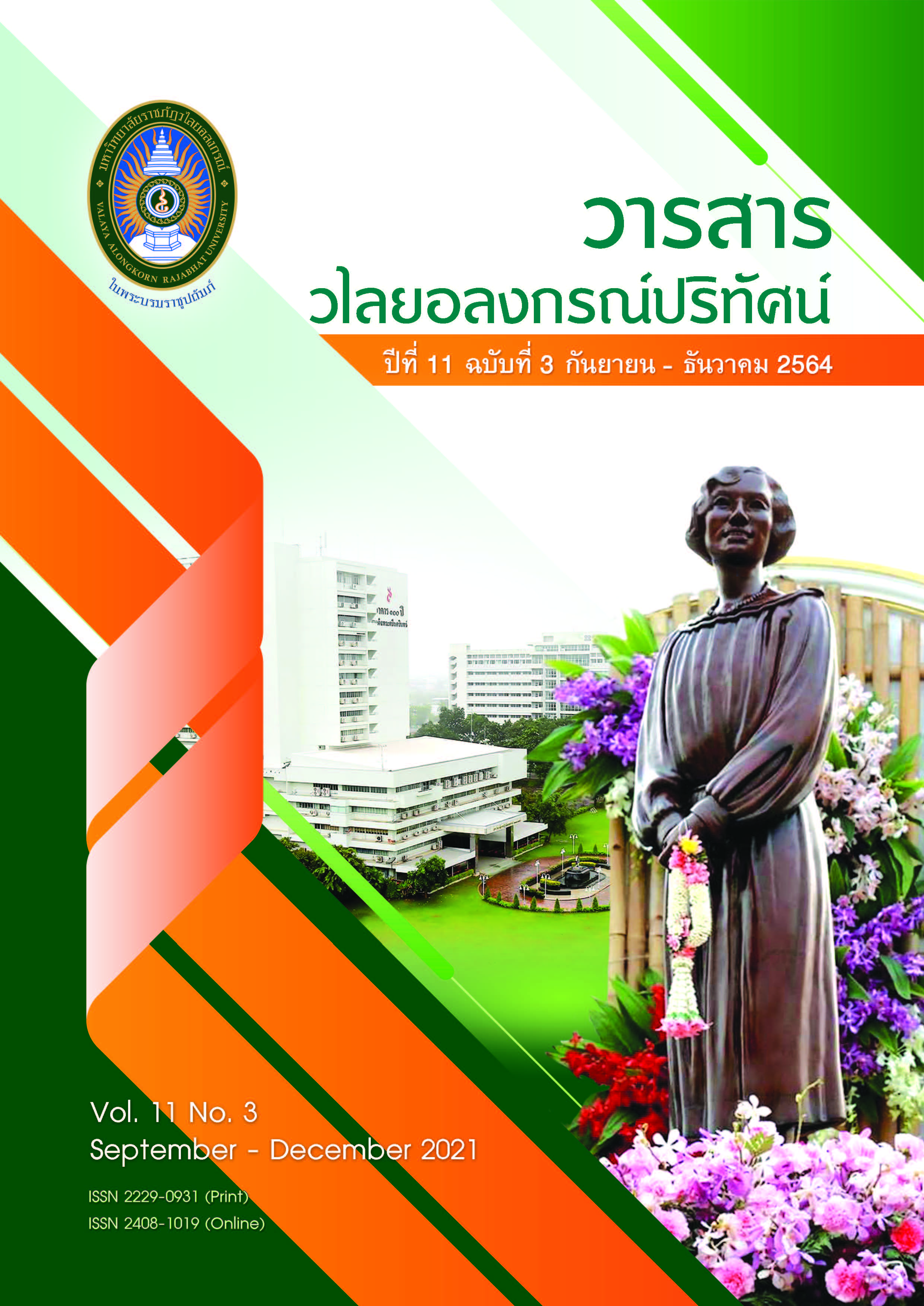กลยุทธ์การตลาดในมุมมองของลูกค้า(4C’s) ที่ส่งผลต่อพฤติกรรมการซื้อสินค้าในห้างสรรพสินค้า ภายใต้สถานการณ์การแพร่ระบาดของโรคติดเชื้อไวรัสโคโรน่า 2019 ของผู้บริโภคในกรุงเทพมหานคร
คำสำคัญ:
กลยุทธ์การตลาด, พฤติกรรมการซื้อ, ห้างสรรพสินค้าบทคัดย่อ
การวิจัยครั้งนี้เป็นการวิจัยเชิงปริมาณ มีวัตถุประสงค์เพื่อศึกษาพฤติกรรมการซื้อสินค้าในห้างสรรพสินค้าภายใต้สถานการณ์การแพร่ระบาดของโรคติดเชื้อไวรัสโคโรน่า 2019 และกลยุทธ์การตลาดในมุมมองลูกค้า(4C’s) ที่ส่งผลต่อพฤติกรรมการซื้อสินค้าในภายใต้สถานการณ์การแพร่ระบาดของโรคติดเชื้อไวรัสโคโรน่า 2019 ของผู้บริโภคในกรุงเทพมหานคร โดยใช้แบบสอบถามเป็นเครื่องมือการเก็บข้อมูลกลุ่มตัวอย่างที่ใช้ในการศึกษา คือ ผู้บริโภคที่อาศัยอยู่ในจังหวัดกรุงเทพมหานครและมีพฤติกรรมการซื้อสินค้าในห้างสรรพสินค้าภายใต้สถานการณ์การแพร่ระบาดของโรคติดเชื้อไวรัสโคโรน่า 2019 จำนวน 400 คน ซึ่งกลุ่มตัวอย่างที่ได้นั้นผู้วิจัยเลือกใช้วิธีการสุ่มกลุ่มตัวอย่างโดยอาศัยความน่าจะเป็นแบบหลายขั้นตอนซึ่งใช้แบบสอบถามเป็นเครื่องมือในการเก็บรวบรวมข้อมูล มีการวิเคราะห์ข้อมูลใช้สถิติเชิงพรรณนา เพื่อการวิเคราะห์ข้อมูลพฤติกรรมการซื้อสินค้าในห้างสรรพสินค้าภายใต้สถานการณ์การแพร่ระบาดของโรคติดเชื้อไวรัสโคโรน่า 2019 และกลยุทธ์การตลาดในมุมมองลูกค้าใช้สถิติเชิงอนุมาน เพื่อวิเคราะห์ข้อมูลเกี่ยวกับกลยุทธ์การตลาดในมุมมองลูกค้าที่ส่งผลต่อพฤติกรรมการซื้อสินค้าในห้างสรรพสินค้าภายใต้สถานการณ์การแพร่ระบาดของโรคติดเชื้อไวรัสโคโรน่า 2019 ของผู้บริโภคในกรุงเทพมหานคร ด้วย ในการวิเคราะห์การถดถอยพหุคูณและมีค่าความเชื่อมั่นทั้งฉบับเท่ากับ .87 โดยเป็นค่าระดับความเชื่อมั่นของคำถามเกี่ยวกับกลยุทธ์การตลาดในมุมมองลูกค้าและคำถามเกี่ยวกับพฤติกรรมการซื้อสินค้าซึ่งเป็นคำถามในรูปแบบของการวัดระดับข้อมูลแบบอันตภาคชั้น
ผลการศึกษาพบว่า ผู้ตอบแบบสอบถามส่วนใหญ่ มีพฤติกรรมการซื้อสินค้าในห้างสรรพสินค้าหลังสถานการณ์โควิด-19 โดยนิยมซื้อสินค้าประเภท อาหาร ขนมคบเคี้ยว หรือร้านอาหาร สาเหตุที่มา คือ สะดวกใกล้บ้านและเชื่อมั่นในมาตรการในการควบคุมเรื่องโรคโควิด-19ของห้างสรรพสินค้า ในการซื้อสินค้าบุคคลที่มีผลต่อการซื้อสินค้าคือตนเอง มาซื้อสินค้า 1-5 ครั้งต่อเดือนและมีค่าใช้จ่ายไม่เกิน 5,000 บาทตามลำดับ และการทดสอบสมมติฐานด้วยสถิติการวิเคราะห์การถดถอยพหุคูณ พบว่า กลยุทธ์การตลาดในมุมมองลูกค้าประกอบด้วย ความต้องการของผู้บริโภค ต้นทุนของผู้บริโภค ความสะดวกในการซื้อ และการสื่อสารที่ส่งผลต่อพฤติกรรมการซื้อสินค้าในห้างสรรพสินค้าภายใต้สถานการณ์การแพร่ระบาดของโรคติดเชื้อไวรัสโคโรน่า 2019 ของผู้บริโภคในกรุงเทพมหานคร อย่างมีนัยสำคัญทางสถิติที่ระดับ .05 ซึ่งจากการทดสอบทำให้ธุรกิจควรคำนึงถึง การวางแผนทางการตลาดโดยเฉพาะในเรื่องของความสะดวกในการซื้อในสถานการณ์ของโรคระบาดทำให้ต้องมีวิธีการในการให้ลูกค้าซื้อสินค้าได้สะดวกขึ้น เน้นสินค้าที่สอดคล้องกับความต้องการของลูกค้าเป็นหลัก เพิ่มการสื่อสารทั้งข้อมูลสินค้า และข้อมูลมาตรการในการดูแลเรื่องโรคไวรัสโคโรน่า 2019
เอกสารอ้างอิง
กมลวรรณ สุขสมัย. (2560). ปัจจัยที่ส่งผลต่อการตัดสินใจใช้บริการศูนย์การค้า. บริหารธุรกิจมหาบัณฑิต คณะพาณิชยศาสตร์และการบัญชี. มหาวิทยาลัยธรรมศาสตร์
จิตรกมล สังข์เพชร และสุพิศ ฤทธิ์แก้ว. (2559). ปัจจัยที่มีความสัมพันธ์กับพฤติกรรมผู้บริโภคในการใช้บริการศูนย์การค้าเซ็นทรัลพลาซ่า สาขาสุราษฎร์ธานี. WMS Journal of Management Walailak University. Vol5., 70-81.
พิมพ์ลภัส วิมลโนธ และพัชร์หทัย จารุทวีผลนุกูล. (2563). ปัจจัยส่วนประสมการตลาดบริการและรูปแบบการดำเนินชีวิตที่ส่งผลต่อการ ตัดสินใจเลือกใช้บริการห้างสรรพสินค้าเซ็นทรัลพลาซาลาดพร้าวของผู้บริโภคใน กรุงเทพมหานคร. น. 337. รายงานสืบเนื่องจากการประชุม การประชุมนำเสนอผลงานวิจัยบัณฑิตศึกษาระดับชาติครั้งที่ 15 ประจำปีการศึกษา 2563. มหาวิทยาลัยรังสิต. ปทุมธานี.
อำนวย ปาอ้าย. (2563). พฤติกรรมการซื้อและความคิดเห็นต่อปัจจัยส่วนประสมการตลาดตลาดนัดของผู้บริโภค ในเขตจังหวัดฉะเชิงเทรา. วารสารราชนครินทร์. กรกฎาคม – ธันวาคม 2563. มหาวิทยาลัยราชภัฏราชนครินทร์.
ปานวาด ธีระพันธ์ศิลปิน. (2562). การตัดสินใจซื้อสินค้าในห้างสรรพสินค้าในเขตปทุมวัน. บริหารธุรกิจมหาบัณฑิต สาขาวิชาการตลาด. มหาวิทยาลัยรามคำแหง
ฑิตาพร รุ่งสถาพร. (2563). พฤติกรรมผู้บริโภคต่อการซื้อสินค้าบนช่องทางออนไลน์ ในภาวะวิกฤตโควิด-19 ในเขตกรุงเทพมหานคร ปริมณฑล และพิษณุโลก. นิเทศศาสตรมหาบัณฑิต สาขาวิชาการสื่อสารการตลาดดิจิตัล มหาวิทยาลัยกรุงเทพ.
ทวิสันต์ โลณานุรักษ์และเสาวลักษณ์ จิตต์น้อม. (2559). กลยุทธ์ทางการตลาดในมุมมองของผู้บริโภคและทัศนคติของผู้บริโภคที่มีอิทธิพลต่อพฤติกรรมการตัดสินใจซื้อในร้านสะดวกซื้อ ในเขตเทศบาลนครนครราชสีมา. น.73. การประชุมวิชาการและเสนอผลงานวิจัยระดับชาติ ครั้งที่ 3 ก้าวสู่ทศวรรษที่ 2:บูรณาการวิจัย ใช้องค์ความรู้สู่ความยั่งยืน. วิทยาลัยนครราชสีมา, นครราชสีมา.
ธนาคารแห่งประเทศไทย. (2564). “จากชีวิตวิถีใหม่ New Normal สู่ชีวิตวิถีถัดไป Next Normal. [Online], เข้าถึงได้จาก:https://www.bot.or.th/Thai/ResearchAndPublications/articles/Pages/Article_11Jan2021.aspx (2564, มกราคม 11).
ปัญจพัฒน์ ประสิทธิ์เดชสกุล. (2563). พลิกโฉมธุรกิจหลังวิกฤตโควิด-19. [Online], เข้าถึงได้จาก: https://www.krungsri.com/bank/getmedia/578838c1-5ffc-47dd-ba5f-f807bc86d248/RI_Post_Covid19_New_Normal_200716_TH.aspx
พิชชานันท์ ฐิติอักษรศิลปะ. (2558). ส่วนประสมทางการตลาดในมุมมองของลูกค้าที่มีอิทธิพลต่อพฤติกรรมการซื้อเสื้อผ้าออนไลน์ของพนักงานบริษัทในกรุงเทพมหานคร. บริหารธุรกิจมหาบัณฑิต สาขาวิชาการตลาด, มหาวิทยาลัยศรีนครินทรวิโรฒ.
มนัสชนก ไชยรัตน์. (2563). พฤติกรรมผู้บริโภคที่เปลี่ยนแปลงไปช่วงสถานการณ์ COVID-19 ในพื้นที่กรุงเทพมหานคร. บริหารธุรกิจมหาบัณฑิต มหาวิทยาลัยรามคำแหง.
ศิริชัย กาญจนวาสี. (2552). สถิติประยุกต์สาหรับการวิจัย. กรุงเทพฯ: สานักพิมพ์แห่งจุฬาลงกรณ์มหาวิทยาลัย.
ศิริวรรณ เสรีรัตน์ และคณะ. (2541). การบริหารการตลาดยุคใหม่. กรุงเทพฯ: ธีระฟิล์มและไซเท็กซ์.
ศิริวรรณ เสรีรัตน์ และคณะ. (2549). การวิจัยการตลาด. กรุงเทพฯ: ธรรมสาร.
ศุภกร สมจิตต์ และสรุสิทธิ์ อุดมธนวงศ์. (2563). ปัจจัยที่ส่งผลต่อการตัดสินใจซื้อสินค้าของ ธุรกิจค้าปลีกญี่ปุ่นที่เข้ามาเปิดตลาดในประเทศไทย กรณีศึกษา ดองกิ มอลล์. การประชุมวิชาการระดับชาติ มหาวิทยาลัยรังสิต ประจำปี 2563. มหาวิทยาลัยรังสิต, กรุงเทพมหานคร.
สุรพงษ์ คงสัตย์ และธีรชาติ ธรรมวงศ์. (2551). การหาค่าความเที่ยงตรงของแบบสอบถาม (IOC). [Online], เข้าถึงได้จาก: https://www.mcu.ac.th/article/detail/14329 (2563, ธันวาคม 24).
อดุลย์ จาตุรงกุล. (2544). พฤติกรรมผู้บริโภค. (พิมพ์ครั้งที่ 6). กรุงเทพฯ: โรงเพิมพ์มหาวิทยาลัยธรรมศาสตร์.
Cochran, W. G. (1953). Sampling Techiques. New York: John Wiley & Sons.
Lauterborn, B. (1990). New Marketing litany; Four Ps passe; C-words take over. Advertising Age,61(41), 26.
Schiffman, L. G., & Kanuk, L. L. (1994). Consumer behavior. (5th ed.). Englewood Cliffs,N. J. : Prentice-Hall.
ดาวน์โหลด
เผยแพร่แล้ว
รูปแบบการอ้างอิง
ฉบับ
ประเภทบทความ
สัญญาอนุญาต
ข้อความที่ปรากฏในบทความแต่ละเรื่องในวารสารวไลยอลงกรณ์ปริทัศน์ เป็นความคิดเห็นของผู้นิพนธ์แต่ละท่าน มิใช่เป็นทัศนะและมิใช่ความรับผิดชอบของกองบรรณาธิการจัดทำวารสาร และ
มหาวิทยาลัยราชภัฏวไลยอลงกรณ์ ในพระบรมราชูปถัมภ์


